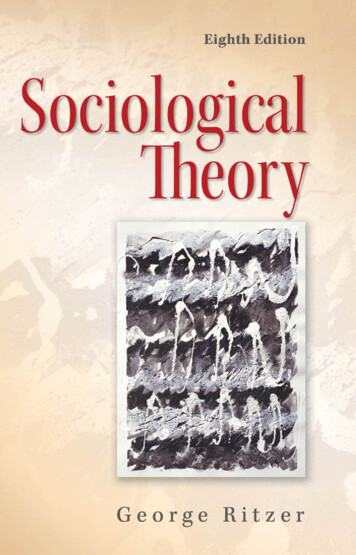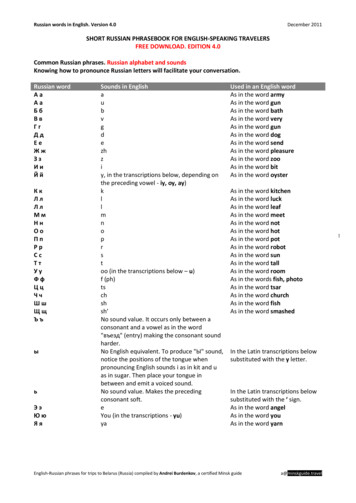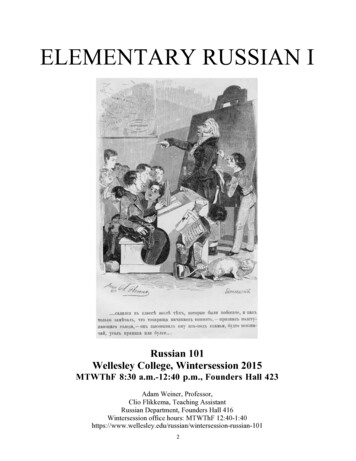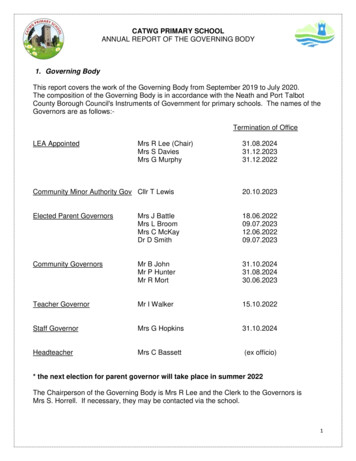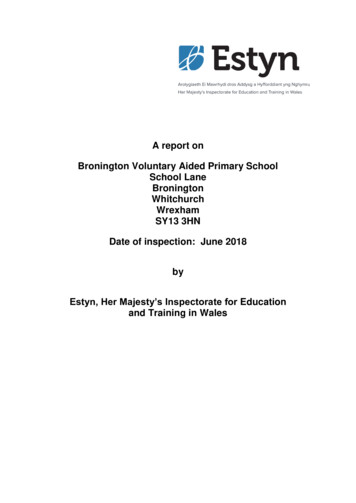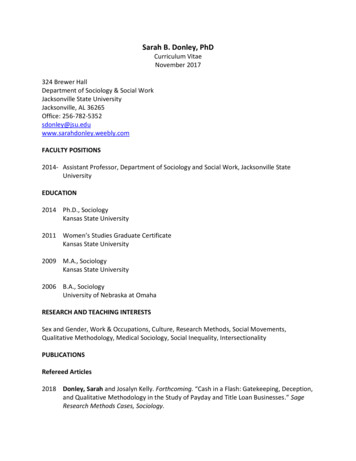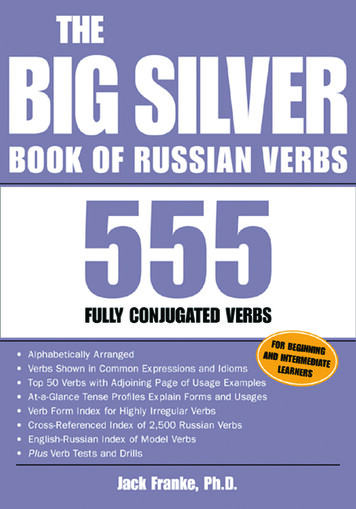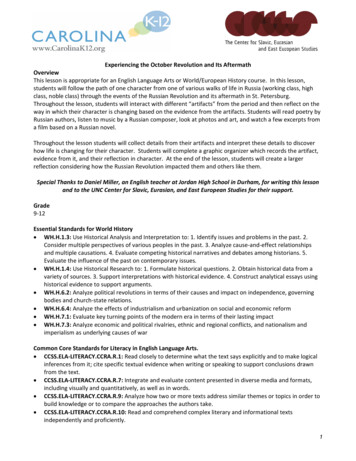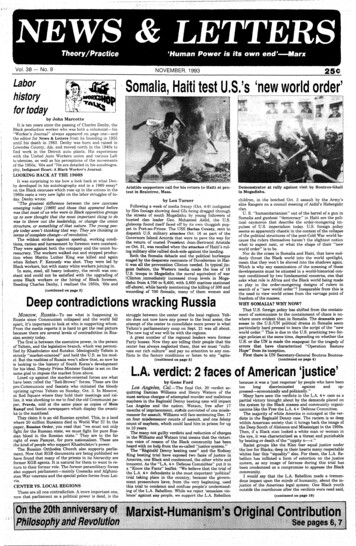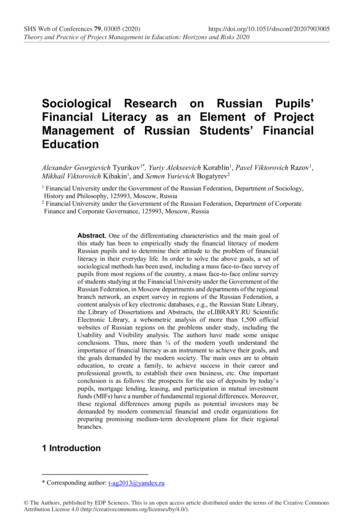
Transcription
SHS Web of Conferences 79, 03005 heory and Practice of Project Management in Education: Horizons and Risks 2020Sociological Research on Russian Pupils’Financial Literacy as an Element of ProjectManagement of Russian Students’ FinancialEducationAlexander Georgievich Tyurikov1*, Yuriy Alekseevich Korablin1, Pavel Viktorovich Razov1,Mikhail Viktorovich Kibakin1, and Semen Yurievich Bogatyrev21Financial University under the Government of the Russian Federation, Department of Sociology,History and Philosophy, 125993, Moscow, Russia2 Financial University under the Government of the Russian Federation, Department of CorporateFinance and Corporate Governance, 125993, Moscow, RussiaAbstract. One of the differentiating characteristics and the main goal ofthis study has been to empirically study the financial literacy of modernRussian pupils and to determine their attitude to the problem of financialliteracy in their everyday life. In order to solve the above goals, a set ofsociological methods has been used, including a mass face-to-face survey ofpupils from most regions of the country, a mass face-to-face online surveyof students studying at the Financial University under the Government of theRussian Federation, in Moscow departments and departments of the regionalbranch network, an expert survey in regions of the Russian Federation, acontent analysis of key electronic databases, e.g., the Russian State Library,the Library of Dissertations and Abstracts, the eLIBRARY.RU ScientificElectronic Library, a webometric analysis of more than 1,500 officialwebsites of Russian regions on the problems under study, including theUsability and Visibility analysis. The authors have made some uniqueconclusions. Thus, more than ¾ of the modern youth understand theimportance of financial literacy as an instrument to achieve their goals, andthe goals demanded by the modern society. The main ones are to obtaineducation, to create a family, to achieve success in their career andprofessional growth, to establish their own business, etc. One importantconclusion is as follows: the prospects for the use of deposits by today’spupils, mortgage lending, leasing, and participation in mutual investmentfunds (MIFs) have a number of fundamental regional differences. Moreover,these regional differences among pupils as potential investors may bedemanded by modern commercial financial and credit organizations forpreparing promising medium-term development plans for their regionalbranches.1 Introduction* Corresponding author: t-ag2013@yandex.ru The Authors, published by EDP Sciences. This is an open access article distributed under the terms of the Creative CommonsAttribution License 4.0 (http://creativecommons.org/licenses/by/4.0/).
SHS Web of Conferences 79, 03005 heory and Practice of Project Management in Education: Horizons and Risks 2020The relevance of this study [1] is an attempt to empirically reveal the social contradiction ofthe modern Russian reality: on the one hand, this is constant quantitative and qualitativegrowth of innovative financial instruments in everyday life, and on the other hand, there isnot always sufficient financial literacy of the population [2]. It means that people do notalways manage to master the existing financial instruments to the proper degree and have toface the need to deal with new ones. The authors start revealing this problem through theexample of pupils as potential users of various financial innovations [3]. This state of thesociety seriously complicates the ability of people to fully use real benefits of the civilizationthemselves, and, in addition, to provide their children with the financial education that isgreatly required today. Therefore, there is a probability of violating the most importantpurpose of the social sphere of the society – expanded social reproduction of one of its mostimportant components – the finances of the social sphere. It is quite obvious that financiallyliterate behavior enables people to achieve success and well-being in the most efficient,“shortest” way, which, in its turn, is the foundation for the sustainable development of thecountry’s economy, as a whole [4].Thus, the main goal is to study the level of Russian pupils’ financial literacy. In order toachieve it, certain tasks were set and solved: a mass face-to-face survey of pupils (N 731)from 66 regions of the country, a mass in-person online survey of students studying at theFinancial University under the Government of the Russian Federation, in Moscowdepartments and departments of the regional branch network (N 4,413 respondents), anexpert survey in Russian regions (N 149), a content analysis of electronic databases of theRussian State Library, the Library of Dissertations and Abstracts, the eLIBRARY.RUScientific Electronic Library, a webometric analysis of more than 1,500 official websites ofRussian regions on the problems under study, including the Usability and Visibility analysis,were carried out.This study has another scientific and practical direction that reflects the modern contentof the pupils’ financial culture [5]. There are the following problems within the authors’scientific and practical interests: the young people’s awareness of the capabilities of modernfinancial instruments to achieve their personal goals, but at the same time the goals demandedby society, the ability to efficiently manage personal funds, the ability to understand thepeculiarities of various financial products and services [6], the availability of relevantinformation on the situation in financial markets, Internet skills for financial education, andother issues under study.2 MethodsThe sociological study of the level of Russian pupils’ financial literacy is only a small partof the larger study on the population’s financial literacy carried out by the scientific andpedagogical staff of the Financial University under the Government of the Russian Federationin 2019 as part of the Strategy for Improving Financial Literacy in the Russian Federationfor 2017 – 2023, approved by Decree of the Government of the Russian Federation No. 2039r dated September 25, 2017. The methods of mass and expert surveys, the content analysison the theme under study, and the webmetric analysis (study of quantitative aspects of usinginformation resources, structures, and technologies in relation to the Internet) of officialwebsites dedicated to Russian regions on the issues under study were used. In particular, inthe spring of 2019, a mass face-to-face online survey of the students studying at the FinancialUniversity under the Government of the Russian Federation, in Moscow departments anddepartments of the regional branch network (N 4,413 respondents) was carried out. InSeptember 2019, a mass face-to-face survey of pupils (N 731) who had arrived from sixtysix regions (some results of this survey are presented in this article) was carried out. In August– September 2019, there was an expert survey in the regions of the Russian Federation, with2
SHS Web of Conferences 79, 03005 heory and Practice of Project Management in Education: Horizons and Risks 2020the possibility of comparing pilot and nonpilot regions (N 149). Besides, a content analysisof electronic databases of the Russian State Library, the Library of Dissertations andAbstracts, the Scientific Electronic Library eLIBRARY.RU, and a webmetric analysis ofmore than 1,500 official websites of Russian regions on the problems under study werecarried out, including the Usability (usability of the website) and Visibility (visibility of thewebsite) analysis.The sources of information include the databases of works of the scientific communitylocated on the largest Russian information and analytical portals in the field of science andelectronic libraries: the Russian State Library [7], the DsLib.net Library of Dissertations andAbstracts [8], the disserCat Scientific Electronic Library of Dissertations and Abstracts [9],and the eLIBRARY.RU Scientific Electronic Library [10]. A content analysis was carriedout according to the form containing the following semantic (key) units: financial literacy,financial behavior, and financially literate behavior, basics of financially literate behavior,types and strategies of financial behavior, financial culture, financial education, and financialcompetence.3 ResultsOne of the distinguishing peculiarities of this study is the identification of the adequateattitude of young people to the problem of financial literacy in their lives [7-11]. The mostexpected answer – “the ability to manage personal funds efficiently” – was given by 80.6 %of the responding pupils (N 731). Perhaps other figures turned out to be more interestingand to some extent unexpected – 76.2 % considered “awareness of the capabilities offinancial instruments to achieve goals” as one of the most important features of the financialliteracy.In addition, the thesis “the ability to understand the features of various financial productsand services” as an indicator of the required knowledge, skills and abilities, i.e., realcompetencies, occupies the worthy place (63.9 %).The self-assessment of own financial literacy by young people, taking into account theabove empiricism, looks quite self-critical. Thus, about 2/3 of the surveyed respondentsconsider themselves financially literate to one degree or another (61.3 %). It means that farfrom every young person considers himself or herself capable of using modern financialinstruments to achieve well-being and success. However, understanding the importance offinancial literacy as an instrument to achieve goals is perhaps even more important today.About one in ten found it difficult to answer the question, and a little more than a quarter saidno to one degree or another (28.7 %) about their own self-assessment of the financial literacy.It means that pupils realize the insufficiency of their potential on this issue.Despite the fact that in their future lives, pupils plan to use financial instruments exactlyas instruments to achieve their goals apparently demanded by the society, the classic bankdeposit was in the first place (52.2 %) among a number of financial instruments to beconsidered.Modern young people use a wide range of information sources, trying not to neglectanything, perhaps except for advertising (3.7 %). The most popular sources include ratingsof financial and credit organizations (80.5 %) and opinions of independent experts (76.2 %).This is a serious attitude to the issue. Further, with a large negative difference, there arerecommendations from acquaintances and relatives (33.5 %), articles in mass media (30.8%), television reports which they do not watch (12.8 %), and reviews on the Internet (6.7 %).It means that today even very young people like the older population are already cautiousabout Internet sources as reliable sources of serious information.In order to study financial strategies of a modern pupil, a game experiment was carriedout. The pupils were asked an open question in the style of Pushkin’s tale about a goldfish:3
SHS Web of Conferences 79, 03005 heory and Practice of Project Management in Education: Horizons and Risks 2020“Imagine the situation where you have personal free funds in the amount of RUB 150 thous.you do not need to give back. How could you manage, spend, invest, and use them in thefinancial market?” The pupils were allowed to answer the question in any way they wanted.As a rule, the respondents expressed several alternatives to their behavior, e.g., to use a partof the money for a deposit in a bank, to spend the other part on highly profitable stocks, andto spend the rest on traveling. Therefore, the pupils’ responses were grouped into sevenpossible inceptive financial strategies. These strategies had a linear mode: investments indeposits – 40.5 %, investments in securities (as a rule, in stocks) – 19.3 %, investments inestablishing own business – 13.4 %, spending money on personal needs – 13.3 % (thisincluded cars, traveling, expensive devices, etc.), difficulties in answering – 9.7 %, variousexpenses (parents, charity, housing conditions, etc.) – 8.2 %, and investments in owneducation – unfortunately, only 7.4 %.The correlations of financial strategies by income clearly show a number of empiricalregularities. Firstly, the young people from low-income families almost twice less often planto deposit money (25 % – 43.1 % – 39.4 %). They are much more likely than others to investin securities (25 % – 21 % – 17.8 %). They are almost twice likely to establish their ownbusiness (20 % – 12.1 % – 14 %).Secondly, none (0 %) of the low-income respondents surveyed will spend the moneyobtained in the offered way on their personal needs, whereas, for example, for the peoplewith an average income, this figure is as much as 14.5 %, and for those with a high income– 13.1 %.Thirdly, the low-income respondents considerably more often have difficulties inanswering (20 % – 5.9 % – 11.9 %). They do not believe in a goldfish even asked to dreamon this. Apparently, they intend to make their fate on their own by taking efforts.4 DiscussionNumerous modern studies on the financial literacy [12-18] often aim either at increasing thepeople’s income, or at the ability to use certain financial instruments, or at researching someof the respondents’ individual characteristics. Thus, German psychologists [19] note that “.the improvement of the financial literacy improves well-being, and higher educationconsiderably enhances this effect for women.” Chinese researchers [20] pay attention toalmost the same thing, but with their characteristic pragmatism: “The growing number of thereferences that pay the main attention to the developed world studies the effects of financialliteracy (or its lack) on the well-being of households”. The respondents’ individualcharacteristics are quite peculiarly characterized by American economists [21]: “. a centralcomponent of the financial literacy is the ability to count and the emotional attitude tonumbers (i.e., the mathematical anxiety). Thus, the driving force of forming the developmentof financial literacy is in the ability to understand numbers and have an emotional attitude tonumbers ”This study has another scientific and practical direction, reflecting the modern content ofthe pupils’ financial culture. It is possible to mention such main expected results in thecontext of the pupils’ attitude to the financial literacy: the ability to efficiently managepersonal funds (80.6 %), the ability to understand the characteristics of various financialproducts and services as an indicator of the required knowledge, skills and abilities, i.e., realcompetencies (63.9 %).In addition, it is necessary to pay attention to the pupils’ final self-assessment. Theybelieve that they can also fully manage the financial resources that are already at theirdisposal. However, earning, and, more than that, increasing money is not their strong pointyet. Apparently, this is a fairly objective self-assessment of their capabilities – the first, ratherreasonable step in mastering financial instruments to achieve goals.4
SHS Web of Conferences 79, 03005 heory and Practice of Project Management in Education: Horizons and Risks 2020Some results of the study are rather interesting and not very expected. 76.5 % of therespondents (more than ¾ of the sampled population !!!) indicated the awareness of thecapabilities of financial instruments to achieve their goals. The goals pupils strive for – toobtain education, create a family, achieve success in a career and professional growth,establish their own business, etc. – are demanded by the modern society. Therefore, theirachievement by using modern innovative financial instruments is an indicator of a rather highfinancial and economic maturity of the modern Russian society. The indicator “awareness ofthe capabilities of financial instruments to achieve goals” with the value of ¾ can be the basisfor the project management of Russian students’ financial education.In addition, it is quite unexpected that the availability of such innovative financialinstruments as an electronic wallet (1.2 %) or using a bank card (3.0 %) as an indicator of thefinancial literacy in terms of importance is within the statistical error of the study, whichsuggests, perhaps, that the availability of financial resources for a certain person does notindicate his or her financial literacy. It means that an electronic wallet and a bank card asperceived by a Russian pupil are just some (quite insignificant) of many indicators of thepractical skills and the ability to use modern financial instruments.It is very interesting that there is a difference in today’s financial behavior and financialstrategies for the future among pupils from megacities and other settlements with less thanone million inhabitants. Mortgage plans are more typical for residents of smaller settlements.Classic deposits are the prerogative of the inhabitants of the megacity. Many other financialinstruments, e.g., MIFs, leasing, and insurance investment are fundamentally more attractivefor nonmegacities.5 ConclusionIn general, the study goals have been achieved. The authors have determined interestingempirical patterns that put the definition of financial literacy in the necessary list ofinstruments for achieving goals: not only improving material well-being, but achieving goalsin the broad sense of the word when tasks demanded by the society are solved.It is noteworthy that such concepts as leasing or MIF have never been mentioned by thepupils from megacities, i.e., people from megacities and, conditionally, from provinces areslightly different, which in general implies a certain difference in the credit and financialpolicy in various regions of the Russian Federation. Moreover, modern commercial financialand credit organizations can take advantage of these differences to form promising mediumterm development plans for their regional branches.References1.2.3.4.5.6.7.8.J. Gathergood, J. Weber, J. Banking Finance 78, 58-83 (2017)M. Muñoz-Murillo, P. B. Álvarez-Franco, D. A. Restrepo-Tobón, J. Behav. Experiment.Econ. 84 (2020)Sh. Clark, M. Paul, R. Aryeetey, G. Marquis, J. Adolescence 68, 94-104 (2018)M. Brown, C. Henchoz, Th. Spycher, J. Econ. Behav. Organ. 150, 62-85 (2018)L. Blue, P. Grootenboer, M. Brimble, Int. Rev. Econ. Educ. 16(Part A), 51-62 (2014)G. Peng, F. Liu, W. Lu, K. Liao, L. Zhu, Finance Res. Letters 26, 56-62 (2018)A.G. Tyurikov, D.A. Kunizheva, Power 28(1), 164-170 (2020)Yu.A. Korablin, D.A. Kunizawa, K.Yu. Mishin, Legal Sci. Scien. Practical J. 11, 34-38(2019)5
SHS Web of Conferences 79, 03005 heory and Practice of Project Management in Education: Horizons and Risks 20209.10.11.12.13.14.15.16.17.18.19.20.21.M.V. Kibakin, N.A. Orekhovskaya, A.G. Tyurikov, P.V. Razov, N.I. Kiseleva, Euras. J.Analyt. Chem. 12(7b), 1283-1289 (2017)O.V. Kuznetsov, M.E. Rodionova, Yu.A. Korablin, Problems risk analys. 16(6), 90-100(2019)A.G. Tyurikov, M.V. Kibakin, Yu.A. Korablin, D.I. Markov, Legal Sci. Scien. PracticalJ. 12, 71-75 (2019)I. B. Duissa, Factors affecting multidimensional financial literacy of College students inthe Middle East, International review of the Economics of education (In press).Available at: https://doi.org/10.1016/j.iree.2019.100173A. Anderson, F. Baker, D. T. Robinson, J. Financ. Econ. 126(2), 383-398 (2017)S.Y. Bogatyrev, J. Rev. Global Econ. 7, 731-739 (2018)D. Nie, E. Panfilova, V. Samusenkov, A. Mikhaylov, Sustainability 12(11), 4412 (2020)X. Feng, B.Lu, X. Song, Sh. Ma, J. Empirical Finance 51, 119-137 (2019).D.A. Brent, M. B. Ward, J. Environment. Econ. Manag. 90, 181-216 (2018)Ch. Lin, Yu-J. Hsiao, Ch.-Yu. Yeh, Pacific-Basin Finance J. 43, 218-237 (2017)Ch. E. Bannier, M. Schwarz, J. Econ. Psy. 67, 66-86 (2018)G. Niu, Y. Zhou, H. Gan, Pacific-Basin Finance J. 59, 101262 (2020)K. Segerlund, T. Lin, C. Strembeck, G. Tingchow, D. Westphal, J. Behav. Experiment.Econ. 74, 18-25 (2018)6
branch network, an expert survey in regions of the Russian Federation, a . mortgage lending, leasing, and participation in mutual investment funds (MIFs) have a number of fundamental regional differences. . electronic libraries: the Russian State Library [7], the DsLib.net Library of Dissertations and Abstracts [8], the disserCat Scientific .
